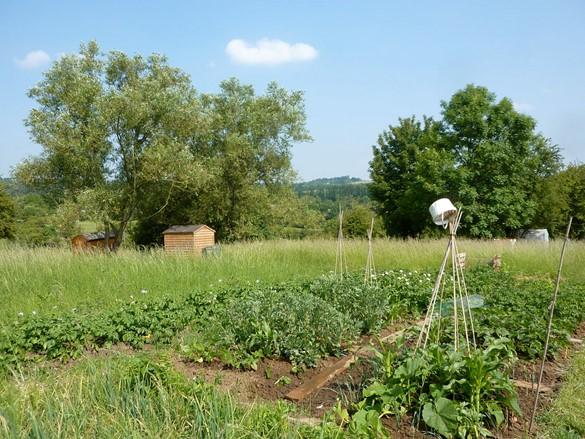
Three Sisters image by allispossible.org.uk is used under the Creative Commons Attribution-NonCommercial 2.0 Generic License (CC BY-NC 2.0)
According to Chavonda Jacobs-Young, Ph.D. Administrator, Agricultural Research Service. U.S. Department of Agriculture, "in agricultural parlance, 'The Three Sisters' are crops planted together in a shared space: maize, beans, and squash…. Developed through [I]ndigenous agricultural practices, these three plants protect and nourish each other in different ways as they grow and provide a solid diet for their cultivators."
The intercropping method of planting corn, beans, and squash together, commonly called The Three Sisters has been studied and described by scholars in anthropology, history, agriculture, and food studies for many years. While this practice is often cited in current sources as a way to improve small gardens for individual use, its historical value lay in larger-scale implementations designed to nurture and sustain entire communities.
The great majority of this research has been created by scholars who were not members of the Indigenous communities which originally developed and maintained this tradition. Thus, this short review will strive to elevate Indigenous authors and practitioners whenever possible, while acknowledging the bulk of the available publications originate from work that did not center their voices.
The Three Sisters: Cultural Aspects
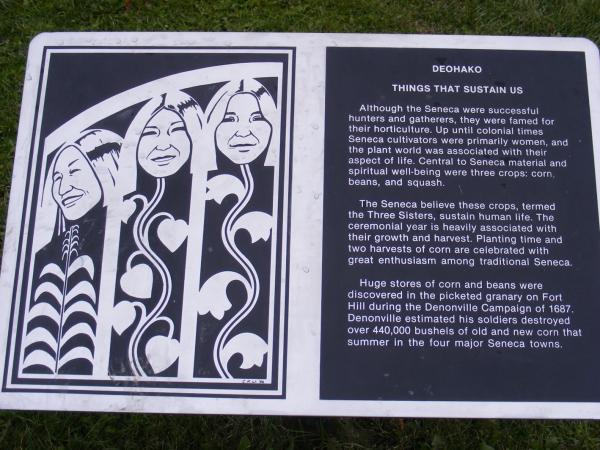
Deoohako: Things That Sustain Us by Don Morfe, October 15, 2009. Database Locator Identification Number: p262825. Courtesy of HMdb.org
The Three Sisters model was not just a means for modeling a specific intercropping practice but was, and is, a significant cultural and spiritual construct.
Diohe'ko, the Three Sisters, had been cultivated for at least five hundred years prior to contact by the Seneca, an Iroquoian tribe inhabiting western New York State. The Three Sisters, corn, beans and squash (pumpkins, gourds), were planted together in hills in fields, cultivated and harvested by work parties of women….The Three Sisters was an important cultural complex. The Sisters are protagonists of a number of Seneca tales, myths, ceremonies and legends. p. 76
Lewandowski, S. (1987). Diohe'ko, the Three Sisters in Seneca life: Implications for a native agriculture in the finger lakes region of New York State. Agriculture and Human Values, 4, 76–93 (1987). https://doi.org/10.1007/BF01530644
The Carnegie Museum of Natural History broadens the classification from the specific Seneca Nation to that of the Haudenosaunee (Iroquois) Confederacy in its description of the Three Sisters.
To the Iroquois people, corn, beans, and squash are the Three Sisters, the physical and spiritual sustainers of life. These life-supporting plants were given to the people when all three miraculously sprouted from the body of Sky Woman's daughter, granting the gift of agriculture to the Iroquois nations.
Carnegie Museum of Natural History. (2018). The Three Sisters: Sustainers of life. https://nsew.carnegiemnh.org/iroquois-confederacy-of-the-northeast/three_sisters/.
In 1910 Arthur Parker observed from his interviews with members of the Seneca Nation,
Among the Senecas, in planting corn the seeds of the squash and bean were sown in every seventh hill because it was thought that the sprits of these three plants were inseparable. They were called Diohe'ko, these sustain us. In the Green Corn Thanksgiving the leader rises and says, 'Diettino'nio dioke'ko, we give thanks to our sustainers.'
Certain woman banded themselves together in a society called the Tonwisas or Towisas Oa'no. The propitiated the spirits of the three sisters by certain ceremonies. In their ceremonial march, Wenuntonwisas, the leader holding an armful of corn and a cake of corn bread leads her band in a measured march about a kettle of corn soup about a kettle of corn soup. p. 27
Parker, A.C. (1910). Iroquois Uses of Maize and Other Food Plants. New York State Museum Bulletin, Number 482. https://www.biodiversitylibrary.org/page/20932470
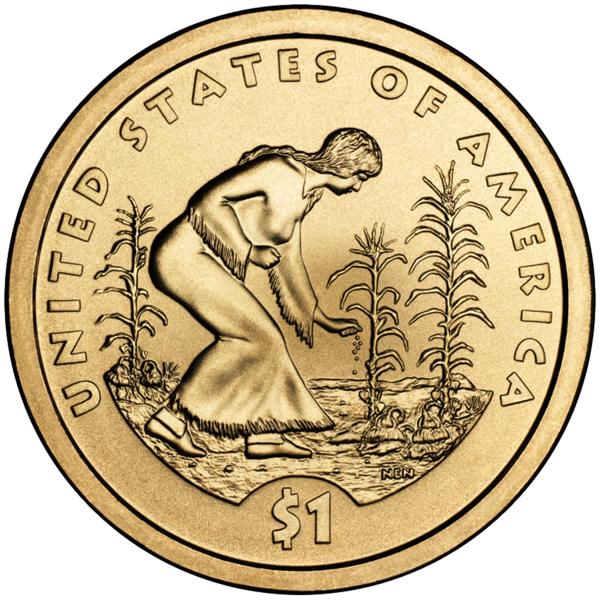
Norman Nemeth. (2021, November 19). 2009 Native American $1 Coin [reverse]. United States Mint. https://www.usmint.gov/coins/coin-medal-programs/native-american-dollar-coins/2009-three-sisters-agriculture.
“…[T]here is a need to understand and truly listen to the stories of Indigenous peoples. Their stories and mythologies hold many truths that have been silenced and washed away from the history making moments for far too long. The Three Sisters Garden is one such cosmological realm that allowed for the survival of many people through hundreds and thousands of years. The Lenni Lenape, potentially, one of the originators of this agricultural practice have tried to share their history from the obscurity of academia and it is far time that their knowledge be welcomed into the mainstream.” p. 51
Holmes, D. (2022). Lenni Lenape and modern practices: Forming a collective model to future agriculture [Unpublished master's thesis]. Harvard University Division of Continuing Education. https://nrs.harvard.edu/URN-3:HUL.INSTREPOS:37371601
Leanne McMillan sums up the practice thusly,
The technique for planting the Three Sisters spread from Mesoamerica northward over many generations, eventually becoming widespread throughout North America. Indigenous farmers saved the best seeds for the following season, resulting in a wide variety of cultivars perfectly suited for the environments in which they were grown. Much of this diversity was sadly lost as indigenous nations were forced out of their ancestral lands by early European settlers and mainstream agricultural practices took hold.
In the area that is now considered northern New York, the Haudenosaunee made great use of companion planting and the Three Sisters were an important part of their diet. Known as the Iroquois by the French and the Six Nations by the British, the Haudenosaunee existed as a matrilineal democratic form of government in North America long before European incursion. The Haudenosaunee considered the Three Sisters to be divine gifts. Some versions of their legends involve the crops personified as three women who separate from each other only to find out that they are stronger together.
McMillan, L. (n.d.). The Three Sisters. The Hand Lens. Specimen Stories. New York Botanical Garden. http://sweetgum.nybg.org/science/the-hand-lens/explore/narratives-details/?irn=7503.
The Three Sisters: Practical Aspects
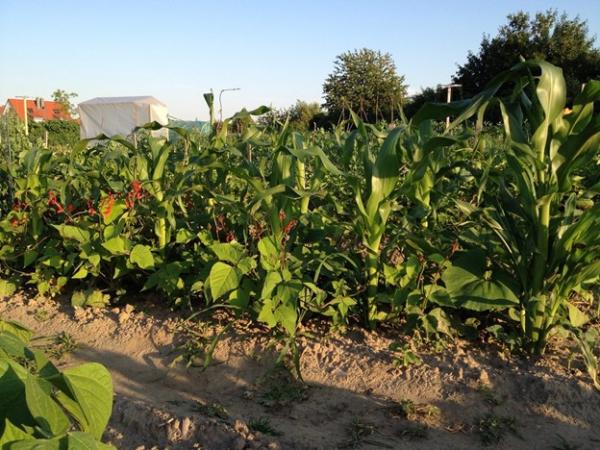
Three Sisters by Joachim Quandt is used under the Creative Commons Attribution-ShareAlike 2.0 Generic License (CC BY-SA 2.0)
The Carnegie Museum of Natural History also provides a useful description of just how this method was carried out.
The Iroquois agricultural system was based on the hill-planting method. Iroquois women, who were responsible for farming, placed several kernels of corn in a hole. As the small seedlings began to grow, the farmers returned periodically to mound the soil around the young plants, ultimately creating a hill one foot high and two feet wide. The hills were arranged in rows about one step apart.
Iroquois women mixed their crops, using a system called "interplanting." Two or three weeks after the corn was planted, the women returned to plant bean seeds in the same hills. The beans contributed nitrogen to the soil, and the cornstalks served as bean poles. Between the rows, the farmers cultivated a low-growing crop such as squash or pumpkins, the leaves of which shaded the ground, preserving moisture and inhibiting weed growth.
Carnegie Museum of Natural History. (2018). The Three Sisters: Sustainers of life. https://nsew.carnegiemnh.org/iroquois-confederacy-of-the-northeast/three_sisters/.
Christina Gish Hill provides some background analysis of how these practices were carried out on a systemic level.
By the time Europeans reached the shores of the Americas, the Indigenous peoples of the northern continent had developed food systems that efficiently utilized their abundant landscape to provide a relatively nutritious diet ….Three sisters agriculture also developed as a central food system in both the North and the Southeast. The Iroquois and the Cherokee called corn, bean, and squash the three sisters' because they nurture each other like family when planted together. These agriculturalists placed corn in small hills planting beans around them and interspersing squash throughout of the field. Beans naturally absorb nitrogen from the air and convert it to nitrates, fertilizing the soil for the corn and squash. In return, they are supported by winding around the corn stalks. The squash leaves provide ground cover between the corn and beans, preventing weeds from taking over the field. These three plants thrive together better than when they are planted alone.
The multicultural research team of Lindsey Lunsford, Melvin L. Arthur, and Christine M. Porter provide a blunter view.
In 1619, an English ship landed on the shores of the Powhatan confederacy, or, as the English called it, Point Comfort, Virginia. The ship delivered stolen people onto stolen land. This was a first step in founding today’s U.S. food system. Until that time, the people of North America and West Africa had lived off the land for millennia, foraging, hunting, and cultivating food. But 400 years ago, the twin European colonial influences of invasion and enslavement entwined the lives and, to some extent, the foodways of Native Americans and West Africans in what is now the U.S.
Lunsford, L., Arthur, M. L., & Porter, C. M. (2021). African and Native American foodways and resilience: From 1619 to COVID-19. Journal of Agriculture, Food Systems, and Community Development, 10(4), (p. 241). https://doi.org/10.5304/jafscd.2021.104.008.
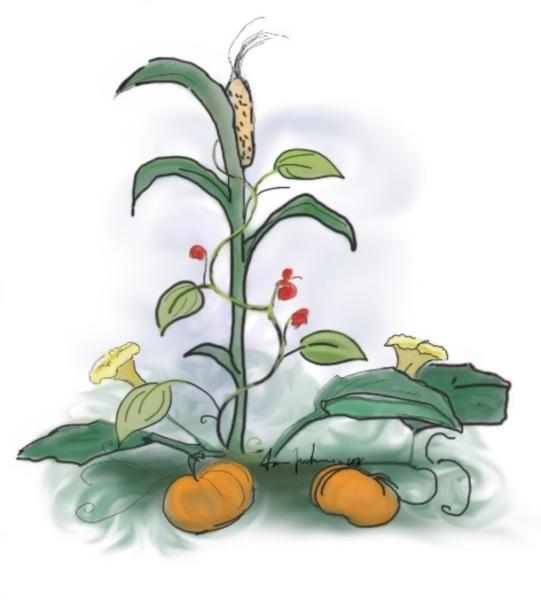
Three Sisters companion planting technique by Anna Juchnowicz is used under the Creative Commons Attribution‐ShareAlike 4.0 License (CC BY‐ SA 4.0)
The Three Sisters: Archeological and Scientific Aspects
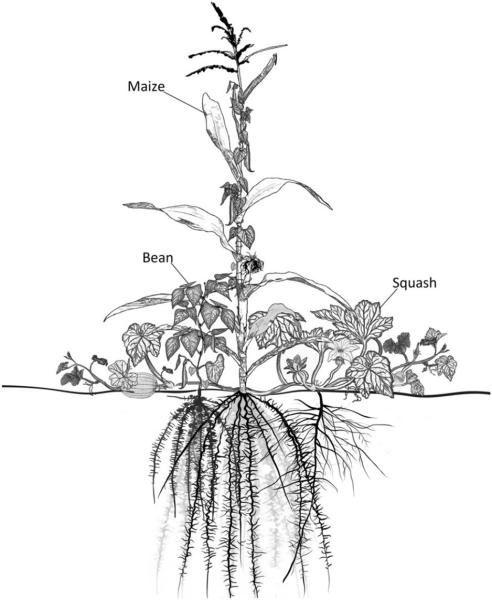
The classic milpa with maize-bean-squash by Lopez-Ridaura, S., Barba-Escoto, L., Reyna-Ramirez, C. A., Sum, C., Palacios-Rojas, N., & Gerard, B. is used under the Creative Commons Attribution 4.0 International License (CC BY 4.0).
Some Indigenous Peoples of the Americas planted corn, beans and squash or pumpkins together in mounds, in an intercropping complex known to some as the Three Sisters. Corn provided support for beans, beans provided nitrogen through nitrogen-fixing rhizobia bacteria that live on the roots, and squash and pumpkins provided ground cover to suppress weeds and inhibit evaporation from the soil. While the origins of the Three Sisters complex are unknown, veneration of the Three Sisters appears in the earliest accounts of European explorers and missionaries in North America. As described by Lewandowski, from its earliest appearance in written records, the Three Sisters complex was not simply an agricultural strategy or technology, but a cultural complex, complete with stories, ceremonies, technology, customs and etiquette.
Archaeological evidence dates the adoption of the Three Sisters complex in North America to 1070 AD. The complex was adapted to local conditions over the 500 years before contact with Europeans, so much so that it was the dominant food plant association of every nation practising agriculture in the northeast USA as well as in several other parts of North America, including southern regions of Quebec and Ontario, Canada. The Indigenous Peoples practising Three Sisters agriculture in the northeastern USA and southeastern Canada included those from at least fifteen nations. p, 2
Ngapo, T.M., Bilodeau, P., Arcand, Y., Charles, M.T., Diederichsen, A., Germain, I., Liu, Q., MacKinnon, S., Messiga, A.J., Mondor, M., et al. (2021). Historical Indigenous food preparation using produce of the Three Sisters intercropping system. Foods, 10, 524. https://doi.org/10.3390/foods10030524.
Hill provides a good lay description of the scientific processes that account for the success of this intercropping practice.
Three sisters agriculture also developed as a central food system in both the North and the Southeast. The Iroquois and the Cherokee called corn, bean, and squash “the three sisters” because they nurture each other like family when planted together. These agriculturalists placed corn in small hills planting beans around them and interspersing squash throughout of the field. Beans naturally absorb nitrogen from the air and convert it to nitrates, fertilizing the soil for the corn and squash. In return, they are supported by winding around the corn stalks. The squash leaves provide ground cover between the corn and beans, preventing weeds from taking over the field. These three plants thrive together better than when they are planted alone.
Hill, C.G. (2016). Pre-Colonial foodways. In Wallach, J.J., Swindall, L.R., & Wise, M.D. (Eds.) The Routledge History of American Foodways (pp. 9-22). London: Routledge Press.
Hart describes the archeological evidence tracing the practices behind this type of inter or polycropping of corn, beans, and squash.
Polycropping maize, bean, and squash has a long history in the Western Hemisphere. Evidence for each of these crops extends back millennia in Central and South America (e.g., Dillehay et al. 2007; Kaplan and Lynch 1999; Piperno and Flannery 2001; Smith 1997) while there are much shorter histories in the North American Southwest, Plains, and East (e.g., Adair 2003; Asch and Hart 2004; Fish 2003; Schneider 2002). However, it does appear that whenever these three crops were available, they were in some manner grown and eaten together (Mt. Pleasant 2006). In fact soon after Europeans arrived in the Western Hemisphere, the three crops were transplanted to Europe and Africa, where they were also often grown and eaten together (e.g.,McCann 2004; Paris 2000; Paris et al. 2006; Rebourg et al. 2004; Zevon 1997). p. 87.
Hart, J.P. (2007). Evolving the Three Sisters: The changing histories of maize, bean, and squash in New York and the greater northeast. In Hart, J.P. (Ed.), Current northeast paleoethnobotany II. New York State Museum Bulletin Series, 512. Albany, NY: The New York State Education Department. https://core.tdar.org/filestore/download/391817/307521.
Marti Dodson places Three Sisters' gardening within the companion planting tradition.
For centuries, many Native American tribes throughout North America have cultivated corn, beans, and squash. The term 'Three Sisters' was primarily used by the Iroquois who live in the Northeastern United States and Canada. These crops were considered to be special gifts from Great Spirit and were believed to be protected by the Three Sisters-spirits collectively called the De-o-ha-ko, meaning 'our sustainers' or 'those who support us' (Eames-Sheavly, 1993).
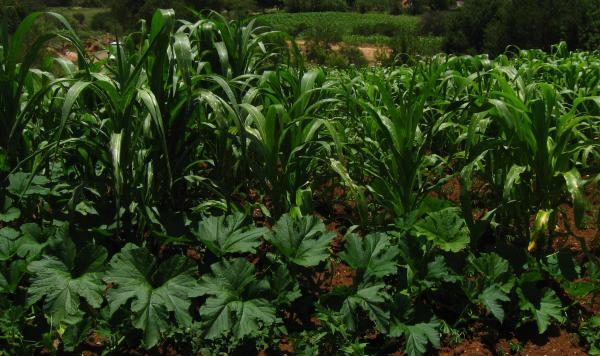
Milpa in Zaragoza, Tilantongo by Paul Rogé is used under the Creative Commons Attribution 4.0 International License (CC BY 4.0)
This ancient style of companion planting has played a key role in the survival of all people in North America. Grown together, these plants are able to thrive and provide high-yield, high-quality crops with a minimal environmental impact. Corn, beans, and squash have a unique symbiotic relationship in a Native American garden. Corn offers a structure for the beans to climb. The beans, in turn, help to replenish the soil with nutrients. And the large leaves of squash and pumpkin vines provide living mulch that conserves water and provides weed control.
Dodson, M. (2001). Appendix: Ancient Companions. In Kuepper, G. & Dodson, M. Companion Planting & Botanical Pesticides: Concepts & Resources. https://attra.ncat.org/publication/companion-planting-resources/.
Three Sisters as an Intercropping Practice
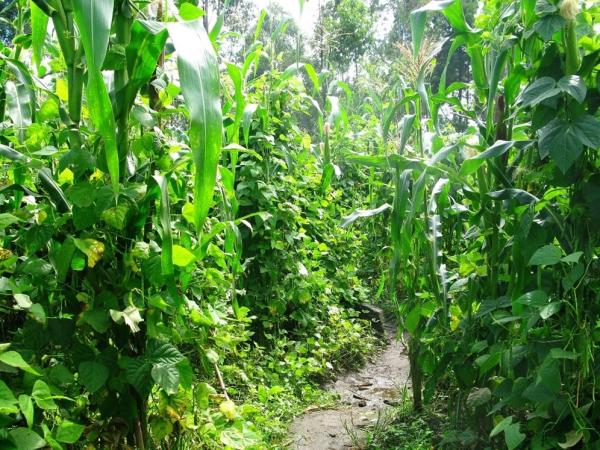
Intercropping maize and beans by AnnaJB is used under the Creative Commons Attribution-Share Alike 4.0 International License (CC BY-SA 4.0)
Charles L. Mohler and Kimberly A. Stoner provide a good overview of the various farming practices that are relevant to Three Sisters' farming:
Intercropping is an all-encompassing term for the practice of growing two or more crops in close proximity: in the same row or bed, or in rows or strips that are close enough for biological interaction. Mixed cropping, companion planting, relay cropping, interseeding, overseeding, underseeding, smother cropping, planting polycultures, and using living mulch are all forms of intercropping.
Mohler, C,L. & Stoner, K.A. (2009). Crop rotation on organic farms: Guidelines for intercropping. Brentwood, MD: Sustainable Agriculture Research and Education (SARE) Publications. https://www.sare.org/wp-content/uploads/Crop-Rotation-on-Organic-Farms.pdf.
Eames-Sheavly describes the benefits and processes behind interplanting within Three Sisters gardens.
The Three Sisters system refers to the planting of corn, pole beans, and squash or pumpkins together in hills. The practice of planting more than one type of crop together is called interplanting. Although this planting system is not common in the United States today, it is in fact a well-thought-out growing method that is used extensively in other countries such as Mexico. Interplanting is corning back into favor for some crops because farmers are finding that large plantings of one crop can have some major disadvantages…. lnterplanting has many advantages. Iroquois farmers adapted this ecological planting method to meet the needs of their crops and their people. Interplanted crops are not as attractive to pests, while large plantings of one crop tend to have more pest problems. The hills provide support around the base of the plants, so they are not as prone to damage from wind. Also, interplanting helps create a uniform stand of corn. The corn forms a support for the beans, and the squash covers the soil. helping to control weeds. p. 3
Eames-Sheavly, M. (1993). The Three Sisters: Exploring an Iroquois garden [PDF, 28 pages]. Ithaka, NY: Cornell University.
A recent study analyzed a similar intercropping practice termed milpa in Guatemala.
The milpa system is the classic example of an efficient multi/mixed-cropping system, which tends to be more productive and efficient in use of light, nutrients and water than monocrop systems, given its internal dynamics of complementarity, competition and facilitation. For example, the mechanisms of interspecific root interactions where maize root exudates promote nodulation of the faba bean, making maize-faba intercrops more efficient than their monocrops have been described.
Lopez-Ridaura, S., Barba-Escoto, L., Reyna-Ramirez, C. A., Sum, C., Palacios-Rojas, N., & Gerard, B. (2021). Maize intercropping in the milpa system. Diversity, extent, and importance for nutritional security in the Western Highlands of Guatemala. Scientific Reports, 11(1), 3696. https://doi.org/10.1038/s41598-021-82784-2.
Seran and Brintha published a review on the aspects of maize-based intercropping practices and observed,
Intercropping of legumes and cereals is an old practice in tropical agriculture that time back to ancient civilization. Snaydon and Harris (1979) found legume-cereal is the most popular intercropping system in the tropics. Systems that intercrop maize with a legume are able to reduce the amount of nutrients taken from the soil as compared to a maize monocrop, p. 139.
Seran, T.H. & Brintha, I. (2010). Review on maize intercropping. Journal of Agronomy, 9(3), 135-145. https://dx.doi.org/10.3923/ja.2010.135.145..
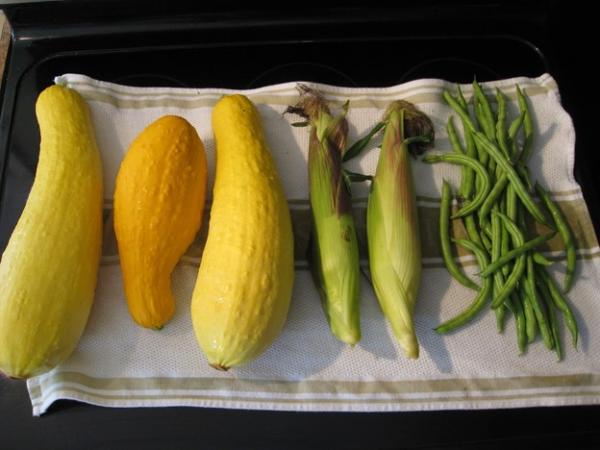
Veggies of our labor by Chris Feser is used under the Creative Commons Attribution 2.0 Generic License (CC BY 2.0)
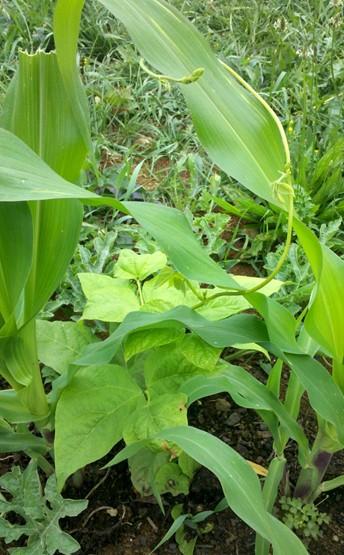
CG Bean Climbing Corn by paix120 is used under the Creative Commons Attribution-NonCommercial 2.0 Generic License (CC BY-NC 2.0)
Finally, a recent meta-analysis of maize/soybean intercropping concluded,
…maize/soybean intercropping is a promising practice to meet the challenge of sustainable development and food security. It is important not only for smallholder agriculture in developing countries, e.g. in Africa, to meet demands for calories and protein (Snapp et al., 2010), but also for organic farming and land sparing in developing countries (Fischer et al., 2008; Phalan et al., 2011). Maize/soybean intercropping can result in major increases in the efficiency of land and N fertilizer use, but this potential is largely untapped in contemporary farming in developed countries…. A multidisciplinary multi-actor approach will be needed, with involvement of stakeholders, to bring these potential advantages of intercropping of maize and soybean to practice.
Xu, Z., Ki, C., Zhang, C., Yu, Y., van der Werf, W., & Zhang, F. (2020). Intercropping maize and soybean increases efficiency of land and fertilizer nitrogen use: A meta-analysis. Field Crops Research, 246(1), 107661. https://doi.org/10.1016/j.fcr.2019.107661.
The USDA Three Sisters Project
The Three Sisters Project is a new program launched by the U.S. Department of Agriculture's Agricultural Research Service. It is described as an "educational outreach initiative to mobilize fresh ideas, talent and diversity in ranks of tomorrow's scientists, technologists, engineers, mathematicians and ag professionals….[which] will engage its scientists and national program staff in fostering opportunities for urban high school students across the country to explore careers in agricultural science and STEM (science, technology, engineering and mathematics) fields overall."
Agricultural Research Service. (2021 February 26). USDA Agricultural Research Service Sets Stage for Next-Generation Researchers. https://www.ars.usda.gov/news-events/news/research-news/2021/usda-agricultural-research-service-sets-stage-for-next-generation-researchers/.
Historical USDA Publications
The U.S. Department of Agriculture published several materials at the start of the twentieth century to relevant to Indigenous agriculture and the techniques related to Three Sisters' gardening. Here is a sample of these publications.
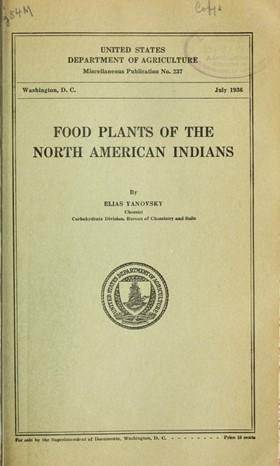
Yanovsky, E. (1936). Food plants of the North American Indians. U.S. Department of Agriculture. Miscellaneous Publication, Number 237. https://archive.org/details/foodplantsofnort237yano.
This publication is a summary of the records of food plants used by the Indians of the United States and Canada which have appeared in ethnobotanical publications during a period of nearly 80 years. This compilation, for which all accessible literature has been searched, was drawn up as a preliminary to work by the Bureau of Chemistry and Soils on the chemical constituents and food value of native North American plants. In a compilation of this sort, in which it is impossible to authenticate most of the botanical identifications because of the unavailability of the specimens on which they were based, occasional errors are unavoidable. All the botanical names given have been reviewed in the light of our present knowledge of plant distribution, however, and it is believed that obvious errors of identification have been eliminated. The list finds its justification as a convenient summary of the extensive literature and is to be used subject to confirmation and correction. In every instance brief references are made to the original authorities for the information cited.
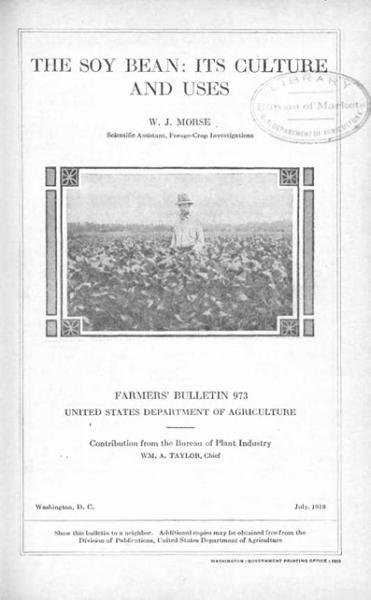
Morse, W.J. (1918). The soy bean: Its culture and uses. Farmers' Bulletin, Number 973. https://archive.org/details/CAT87202617.
The soy bean may be satisfactorily grown in combination with other farm crops. Although the chief advantage, perhaps, is a better balanced ration, the results of experiments indicate a larger yield of forage, as well as a greater variety….Soy beans are more generally grown with corn than with any other crop. Various methods of growing the two crops are practiced in different areas of the country. The beans may be planted in the same hills with the corn, in alternate hills with corn in the same row, in alternate rows of each, or there may be two rows of each." p. 18
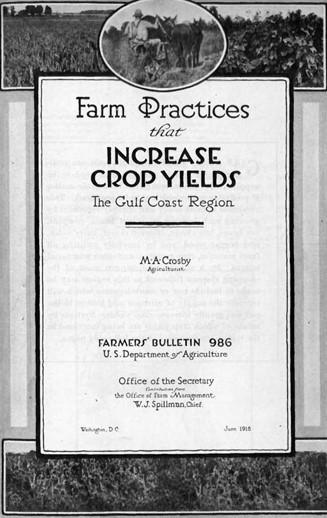
Crosby, M.A. (1918). Farm practices that increase crop yields: The Gulf Coast region. Farmers' Bulletin, Number 986. https://archive.org/details/CAT10308363.
Intercropping with legumes—that is, growing some leguminous crop between the rows of intertilled crops, such as corn or cotton—is the simplest system of growing crops for soil improvement. This practice is an inexpensive and easy means of increasing crop yields, yet, while common in many sections, is not followed to the extent that it should be. The continuous growing of any one intertilled crop on the same land for a succession of years is not good farm practice; but where this is the custom, as is the case in many sections, the practice of intercropping with legumes will frequently keep a sufficient supply of humus in the land to maintain crop yields.
Corn lends itself better to the practice of intercropping than any other crop of this region, and it is with the corn crop that the greatest possibilities are offered for soil improvement by this system. Crops used in this region for intercropping are cowpeas, soy beans, peanuts, velvet beans, and beggar weed." p. 19.
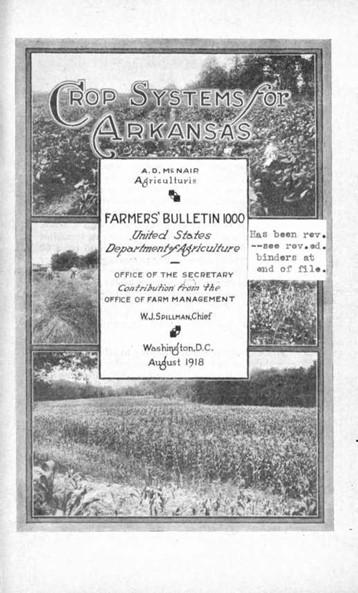
McNair, A.D. (1918). Crop systems for Arkansas. Farmers' Bulletin, Number 1000. https://archive.org/details/CAT87205204.
Crop systems for Arkansas that make for increased food productions and increased efficiency in man labor and horse labor are described in the following pages. By the introduction of cowpeas, soy beans, and other legumes, and by second cropping, provision is made for a considerable increase in the number of crop acres that can be farmed by the average family. Thus, two men with a team, who under a cotton and corn system can farm but 33 acres of land, can handle 50 acres and raise 62 acres of crops under a system providing for a 4-year rotation, including (1) cotton with a winter cover crop, (2) cowpeas, (3) oats or wheat followed by cowpeas, and (4) corn.
References
Agricultural Research Service. (2021 February 26). USDA Agricultural Research Service Sets Stage for Next-Generation Researchers. https://www.ars.usda.gov/news-events/news/research-news/2021/usda-agricultural-research-service-sets-stage-for-next-generation-researchers/.
Eames-Sheavly, M. (1993). The Three Sisters: Exploring an Iroquois garden. Ithaka, NY: Cornell University. https://ecommons.cornell.edu/handle/1813/3621.
Hart, J. P. (2003). Rethinking the Three Sisters. Journal of Middle Atlantic Archaeology, 19, 73‐82.
Hart, J.P. (2007). Evolving the Three Sisters: The changing histories of maize, bean, and squash in New York and the greater northeast. In Hart, J.P. (Ed.), Current northeast paleoethnobotany II. New York State Museum Bulletin Series , 512. Albany, NY: The New York State Education Department (pp. 87-99). https://exhibitions.nysm.nysed.gov/publications/bulletin/512-16671.pdf
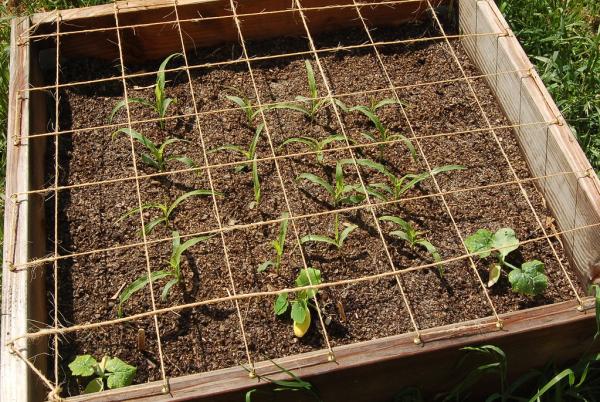
Three Sisters by Lionel & Heidi is used under the Creative Commons Attribution-NonCommercial-NoDerivs 2.0 Generic License (CC BY-NC-ND 2.0)

20110427-OSEC-LSC-0416 by U.S. Department of Agriculture is used under the Creative Commons Attribution-NoDerivs 2.0 Generic License (CC BY-ND 2.0)
Hill, C.G. (2016). Pre-Colonial foodways. In Wallach, J.J., Swindall, L.R., & Wise, M.D. (Eds.) The Routledge History of American Foodways (pp. 9-22). London: Routledge Press.
Hill, C.G. (2020). Returning corn, beans, and squash to Native American farms. The Conversation. Iowa State University. https://theconversation.com/returning-the-three-sisters-corn-beans-and-squash-to-native-american-farms-nourishes-people-land-and-cultures-149230.
Hirst, K. Kris. (2020). The Three Sisters: The traditional intercropping agricultural method. https://www.thoughtco.com/three-sisters-american-farming-173034.
LaDuke, W. (2005). Recovering the sacred: The power of naming and claiming. Cambridge, MA: South End Press. https://archive.details/recoveringsacred00ladu.
Landon, A.J. (2008). The "How" of the Three Sisters: The origins of agriculture in Mesoamerica and the human niche. Nebraska Anthropologist, 40,110‐ 124. https://digitalcommons.unl.edu/nebanthro/40.
Lopez-Ridaura, S., Barba-Escoto, L., Reyna-Ramirez, C. A., Sum, C., Palacios-Rojas, N., & Gerard, B. (2021). Maize intercropping in the milpa system. Diversity, extent, and importance for nutritional security in the Western Highlands of Guatemala. Scientific Reports, 11(1), 3696. https://doi.org/10.1038/s41598-021-82784-2.
Lunsford, L., Arthur, M. L., & Porter, C. M. (2021). African and Native American foodways and resilience: From 1619 to COVID-19. Journal of Agriculture, Food Systems, and Community Development, 10(4), 241–265. https://doi.org/10.5304/jafscd.2021.104.008.
McMillan, L. (n.d.). The Three Sisters. The Hand Lens. Specimen Stories. New York Botanical Garden. http://sweetgum.nybg.org/science/the-hand-lens/explore/narratives-details/?irn=7503..
Mt. Pleasant, J. (2016). Food yields and nutrient analyses of the Three Sisters: A Haudenosaunee cropping system. Ethnobiology Letters,7(1), 87‐98. https://doi.org/10.14237/ebl.7.1.2016.721.
Ngapo, T.M., Bilodeau, P., Arcand, Y., Charles, M.T., Diederichsen, A., Germain, I., Liu, Q., MacKinnon, S., Messiga, A.J., Mondor, M., et al. (2021). Historical Indigenous food preparation using produce of the Three Sisters intercropping system. Foods, 10, 524. https://doi.org/10.3390/foods10030524.
Parker, A.C. (1910). Iroquois Uses of Maize and Other Food Plants. Albany, NY: University of the State of New York. https://archive.org/details/iroquoisusesofma00parkrich.
Seran, T.H. & Brintha, I. (2010). Review on maize intercropping. Journal of Agronomy, 9(3), 135-145. https://dx.doi.org/10.3923/ja.2010.135.145.
Xu, Z., Ki, C., Zhang, C., Yu, Y., van der Werf, W., & Zhang, F. (2020). Intercropping maize and soybean increases efficiency of land and fertilizer nitrogen use: A meta-analysis. Field Crops Research, 246(1), 107661. https://doi.org/10.1016/j.fcr.2019.107661.
Yanovsky, E. (1936). Food plants of the North American Indians. U.S. Department of Agriculture. Miscellaneous Publication, Number 237. https://archive.org/details/foodplantsofnort237yano.
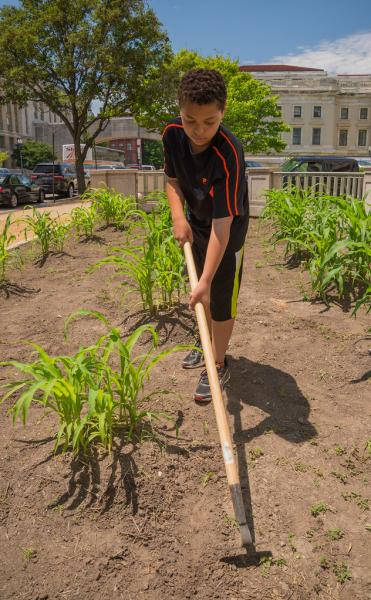
20140604-OSEC-RBN-5577 by U.S. Department of Agriculture is used under the Creative Commons Attribution 2.0 Generic License (CC BY 2.0)
 An official website of the United States government.
An official website of the United States government.